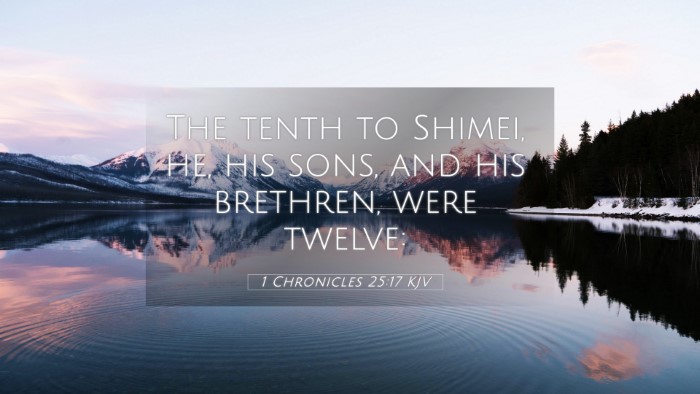Understanding 1 Chronicles 25:17
Bible Verse: 1 Chronicles 25:17 - "The tenth to Zechariah, his sons and his brethren, were twelve."
Overview of the Verse
In 1 Chronicles 25, the chapter outlines the organization of musicians who served in the temple to enhance the worship experience. This specific verse pertains to Zechariah and his division in the temple service, highlighting the structure and leadership within the Levitical musicians. This serves as a historical account of the responsibilities assigned within the sacred service.
Meaning and Insights from Commentaries
Matthew Henry's Commentary
Matthew Henry emphasizes the importance of order and organization in worship. He notes that the division of the musicians was meant to ensure that worship would be carried out effectively and reverently. Each group had its designated leaders, which reflects God's desire for order in divine service.
Albert Barnes' Commentary
Albert Barnes elaborates on the specific mention of Zechariah in relation to his lineage, emphasizing that he was not simply a leader but also part of a greater Levitical tradition. The repetition of the number twelve symbolizes completeness and divine order, suggesting that God's appointments in service are purposeful and significant.
Adam Clarke's Commentary
Adam Clarke dives deeper into the musical aspects of this verse, indicating that these divisions were not merely about numbers but also about the skillfulness of the musicians. He points out the importance of talent in serving God, as these musicians were an integral part of the temple's worship, contributing to the spiritual atmosphere.
Bible Cross-References
1 Chronicles 25:17 connects with several other scriptures, enhancing understanding through cross-references:
- 1 Chronicles 15:22 - Discusses the leaders of music in worship and their roles.
- 2 Chronicles 5:12-13 - Describes the Levites who were musicians during the Ark’s entrance to the Temple.
- 1 Samuel 10:5 - Relates to prophetic music, indicating the spiritual importance of music in prophetic encounters.
- Psalms 137:2 - Reflects the power of music in expressing emotions during trials, common among the Levites.
- Ephesians 5:19 - Encourages speaking to one another in psalms and hymns, connecting New Testament worship practices to Old Testament traditions.
- Colossians 3:16 - Similar to Ephesians, it underscores the significance of music as part of worship.
- Revelation 14:3 - Presents a picture of worship in heaven filled with music, showing continuity from Old Testament worship.
Thematic Connections
This verse, along with its cross-references, creates thematic connections that reveal the role of music in worship throughout the Bible:
- Order in Worship: The organized divisions of musicians reflect the overall theme of divine order in approaching God.
- Continuity of Worship: Understanding the historical context of worship practices informs how we approach worship today.
- Significance of the Levites: The Levites' unique role emphasizes the importance of dedicated service in worship.
Conclusion
1 Chronicles 25:17 serves as a vital piece in understanding the structure and organization of worship, highlighting the important role of musicians in the temple service. It emphasizes the continuity of worship practices from the Old Testament into the New Testament, revealing God's intentions for structured and reverent worship. Through comparative Bible verse analysis and cross-referencing, deeper insights into themes of worship emerge, showing the holistic approach to understanding scripture.


